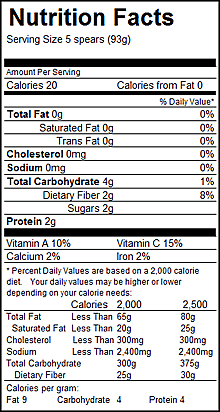Contents:
Common Names | Parts Usually Used | Plant(s) & Culture | Where Found | Medicinal Properties | Biochemical Information
Legends, Myths and Stories | Uses | Nutrient Content | How Sold | Warning | Bibliography
Scientific Names

- Asparagus officinalis L.
- Liliaceae
- Lily family
Common Names
- Sparrow grass
Parts Usually Used
Young shoots, seed, and root
Back to Top
Description of Plant(s) and Culture
Asparagus is a perennial plant; the short, horizontal rootstock has long, thick roots and sends up the young shoots that we eat as vegetables. If allowed to mature, these become branched stems that reach 5 feet in height. What look like leaves on the stem and branches are actually filiform branches which are clustered in the axils of the scaly, inconspicuous leaves (actually branches functioning as leaves). In May and June the plant bears small, solitary, pendulous, bell-shaped, greenish-white, seldom noticed, flowers. The fruit is a red berry, about
Back to Top
Where Found
Generally cultivated for food but may be found growing wild around old garden sites and in waste places.
Back to Top
Medicinal Properties
Aperient, diaphoretic, diuretic, nutritive, demulcent
Back to Top
Biochemical Information
Asparagin, sucrose, starch, and mucilage, folic acid, steroidal glycosides
Back to Top
Legends, Myths and Stories
Asparagus is a highly regarded herb worldwide. Chinese pharmacists save the best roots of this plant for their families and friends in the belief that it will increase feelings of compassion and love. In India, asparagus is used to promote fertility, reduce menstrual cramping and increase milk production in nursing mothers. In the Western world, it has been touted as an aphrodisiac. These customs and beliefs are not mere superstition: the root contains compounds called steroidal glycosides that directly affect hormone production and may very well influence emotions. High in folic acid, which is essential for production of new red blood cells. Eat the young shoots and seeds.
Back to Top
Uses
Acts to increase cellular activity in the kidneys and so increases the rate of urine production. Do not use asparagus when the kidneys are inflamed. Encourages evacuation of the bowels by increasing fecal bulk with undigested fiber. Recommended for gout, dropsy, and rheumatism. Not recommended for podagra. The powdered seed relieves nausea and calms the stomach. Japanese report green asparagus aids protein conversion into amino acids. The roots considered diuretic, laxative, induce sweating. Chinese report that the roots can lower blood pressure. Seeds have antibiotic properties.
Back to Top
Nutrient Content

How Sold
Supermarkets for vegetable tops Seed in powder form
Back to Top
Warning
May cause dermatitis. Do not use asparagus if diarrhea is present. Do not use if kidneys are inflamed, because it increases the rate of urinary production.
Back to Top
Bibliography
![]() The Complete Medicinal Herbal
The Complete Medicinal Herbal, by Penelope Ody, Dorling Kindersley, Inc, 232 Madison Avenue, New York, NY 10016, First American Edition, copyright 1993
![]() Culpeper’s Complete Herbal & English Physician: Updated With 117 Modern Herbs
Culpeper’s Complete Herbal & English Physician: Updated With 117 Modern Herbs, by Nicholas Culpeper, Meyerbooks, publisher, PO Box 427, Glenwood, Illinois 60425, 1990, (reprint of 1814)
![]() Eastern/Central Medicinal Plants
Eastern/Central Medicinal Plants, by Steven Foster and James A. Duke., Houghton Mifflin Company, 215 Park Avenue South, New York, NY 10000
![]() The Herb Book
The Herb Book, by John Lust, Bantam Books, 666 Fifth Avenue, New York, NY. copyright 1974.
 Old Ways Rediscovered
Old Ways Rediscovered, by Clarence Meyer, Meyerbooks, publisher, PO Box 427, Glenwood, Illinois 60425, published from 1954, print 1988
 Earl Mindell’s Herb Bible
Earl Mindell’s Herb Bible, by Earl Mindell, R.Ph., Ph.D., Simon & Schuster/Fireside, Rockefeller Center 1230 Avenue of the Americas, New York, New York 10020
![]() Planetary Herbology
Planetary Herbology, by Michael Tierra, C.A., N.D., O.M.D., Lotus Press, PO Box 325, Twin Lakes. WI 53181., Copyright 1988, published 1992
![]() Webster’s New World Dictionary
Webster’s New World Dictionary, Third College Edition, Victoria Neufeldt, Editor in Chief, New World Dictionaries: A Division of Simon & Schuster, Inc., 15 Columbus Circle, New York, NY 10023
![]() The Yoga of Herbs: An Ayurvedic Guide to Herbal Medicine
The Yoga of Herbs: An Ayurvedic Guide to Herbal Medicine, by Dr. David Frawley & Dr. Vasant Lad, Lotus Press, Twin Lakes, Wisconsin, Second edition, 1988.
